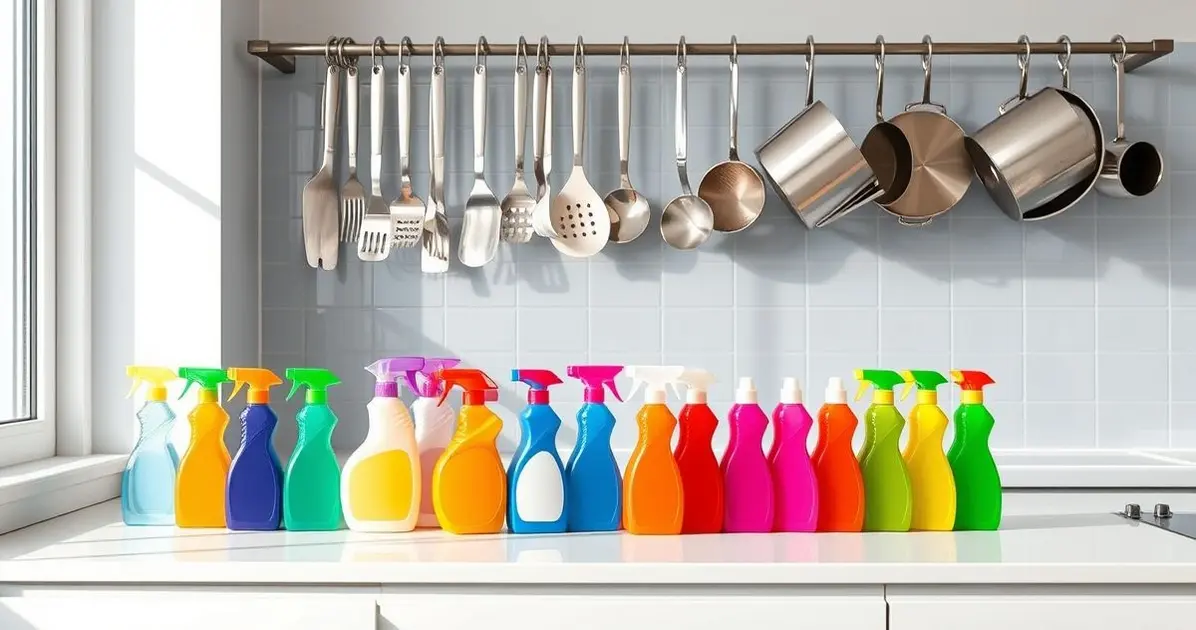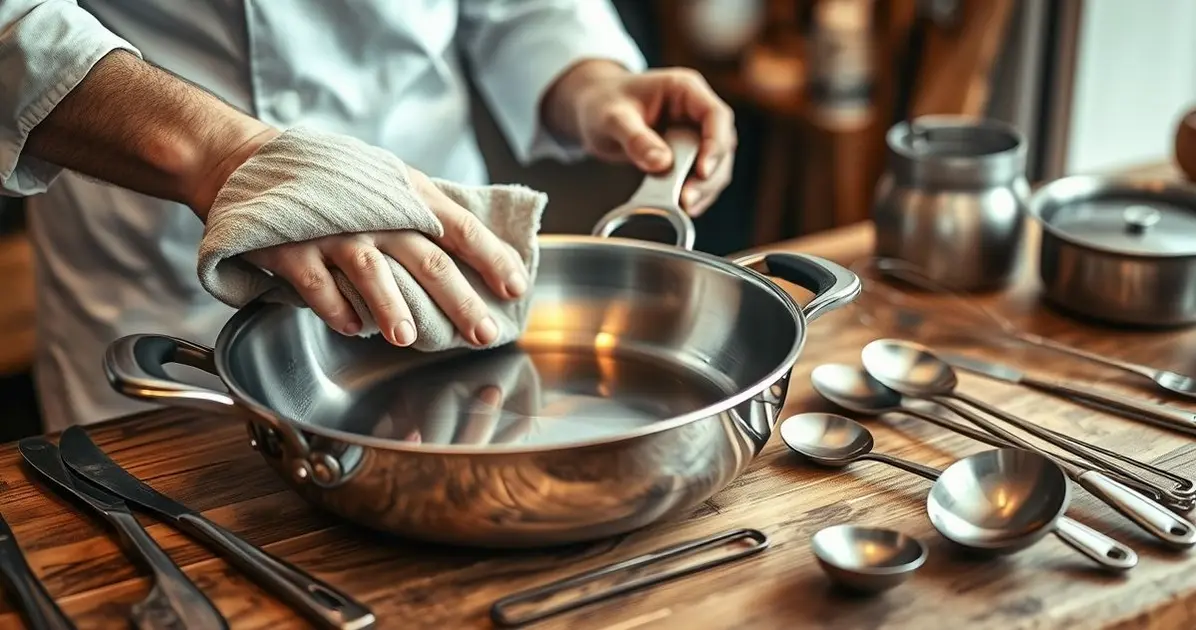Maintaining your cooking tools and equipment is crucial for both safety and efficiency in the kitchen. Regular cleaning, proper storage, and timely replacements can prolong their lifespan and enhance your cooking experience.
How to maintain tools and equipment in cooking

To ensure longevity and optimal performance, regularly clean and store your cooking tools properly. Sharpen knives, wash wooden utensils by hand, and avoid soaking them in water. A well-maintained set of equipment will make your cooking safer and more enjoyable.
Practical Tips for Cleaning Cooking Tools
Keeping your cooking tools clean is essential for maintaining hygiene and ensuring they last longer. Here are some practical tips for cleaning cooking tools:
1. Clean Immediately After Use: To prevent food residues from hardening, wash your cooking tools immediately after use. Rinse utensils, pots, and pans with warm water to make cleaning easier.
2. Use Mild Dish Soap: For most cooking tools, a mixture of warm water and mild dish soap is effective. Avoid harsh chemicals that can damage the surfaces of your tools.
3. Pay Attention to Material: Different materials require specific cleaning methods:
- Stainless Steel: Use a non-abrasive sponge and warm, soapy water. For tough stains, a baking soda paste can help.
- Plastic: Wash with warm, soapy water, and avoid using abrasive scrubbers that can scratch the surface.
- Wood: Hand wash wooden utensils with mild soap and water. Avoid soaking them, as this can lead to warping.
- Silicone: Silicone tools can be cleaned with warm, soapy water or placed in the dishwasher.
4. Rinse Thoroughly: After cleaning, rinse each tool under warm running water to remove all soap and cleaning agents. This ensures that no residues are left behind.
5. Disinfect When Necessary: For added hygiene, especially after using tools with raw meat, consider disinfecting them using a solution of equal parts vinegar and water.
6. Dry Completely: After washing, dry your cooking tools thoroughly with a clean towel or let them air dry. Ensuring they are completely dry prevents moisture buildup, which can lead to bacteria growth.
7. Store Properly: Once dry, store your tools in a clean, organized manner. Use drawer organizers for utensils and keep pots and pans arranged to prevent scratches.
By following these practical tips for cleaning cooking tools, you can maintain a hygienic kitchen environment and prolong the life of your cooking essentials, ensuring they remain effective and safe for food preparation!
Effective Storage Solutions for Kitchen Equipment
Having effective storage solutions for your kitchen equipment is essential for maintaining an organized and efficient cooking environment. Here are some effective storage solutions for kitchen equipment:
1. Utilize Vertical Space: Maximize your kitchen’s vertical space by installing shelves or cabinets that reach up to the ceiling. Store less frequently used items on higher shelves and keep daily essentials within easy reach.
2. Drawer Organizers: Invest in drawer organizers to keep utensils, cutlery, and small tools neatly arranged. These dividers help prevent clutter and make it easy to find what you need quickly when cooking.
3. Magnetic Strips: Install magnetic strips on walls or inside cabinet doors to hold knives and metal utensils. This not only saves drawer space but also keeps your tools visible and easily accessible.
4. Hanging Racks: Use hanging racks or pot racks to store pots, pans, and cooking tools. This method frees up cabinet space and allows you to display your cookware as part of your kitchen decor.
5. Clear Storage Containers: Store dry ingredients like flour, sugar, and pasta in clear, labeled containers. This not only keeps your pantry organized but also makes it easy to see when supplies are running low.
6. Lazy Susans: Incorporate lazy Susans in cabinets or on countertops to easily access spices, condiments, or other small items. This rotating storage solution maximizes space and minimizes the need to reach into the back of cabinets.
7. Under-Sink Storage: Use tiered organizers or pull-out bins under the sink to store cleaning supplies and dish soap. This area is often underutilized, and effective organization can keep it tidy and functional.
8. Cabinet Door Storage: Utilize the inside of cabinet doors for additional storage. Install hooks or small racks to hold measuring spoons, pot lids, or spices, making use of often-overlooked space.
9. Stackable Bins: Use stackable bins to store similar items together, such as baking supplies or snacks. This method keeps items organized and allows you to utilize vertical space effectively.
10. Label Everything: Consider labeling storage containers, shelves, and drawers to make it easy for everyone in the household to find and return items to their proper places. This simple practice helps maintain organization and reduces clutter.
By implementing these effective storage solutions, you can significantly enhance the organization and efficiency of your kitchen. An organized kitchen not only makes cooking more enjoyable but also promotes a safer and more functional cooking environment!

Regular Checks and Maintenance Strategies
Regular checks and maintenance are crucial for ensuring that your cooking tools and equipment remain in optimal condition. Here are some effective maintenance strategies to keep your kitchen essentials safe and functional:
1. Routine Inspections: Schedule regular inspections of your cooking tools and equipment to identify any signs of wear and tear:
- Check for Damage: Look for cracks, dents, rust, or any other damage that could affect performance or safety. Replace any damaged items promptly.
- Assess Sharpness: For knives and other cutting tools, regularly check the sharpness. Dull blades can be dangerous and inefficient, so sharpen them as needed.
2. Clean and Sanitize Regularly: Incorporate cleaning and sanitizing into your routine to prevent bacteria buildup:
- Daily Cleaning: Clean utensils and surfaces after each use, especially after handling raw meat or poultry.
- Weekly Deep Cleaning: Set aside time each week for a more thorough cleaning of pots, pans, and appliances.
3. Proper Storage Practices: Ensure that your tools and equipment are stored correctly to prolong their lifespan:
- Organize Storage Areas: Keep your kitchen organized with designated storage solutions, such as drawer organizers and hanging racks.
- Store in a Dry Place: Avoid storing items in damp areas, as moisture can lead to rust and mold.
4. Follow Manufacturer Guidelines: Adhere to the manufacturer’s instructions for maintenance and care:
- Check Warranty Information: Be aware of any warranty terms and conditions, which may include specific maintenance requirements.
- Use Recommended Cleaning Products: Follow recommendations for cleaning agents and procedures to avoid damaging your tools.
5. Keep a Maintenance Log: Maintain a log of when you perform checks, cleaning, and maintenance:
- Track Usage: Note how often you use each tool, as frequent use may require more regular maintenance.
- Schedule Reminders: Set reminders for regular checks and cleaning tasks to ensure they are not overlooked.
6. Educate Yourself and Others: Ensure that everyone who uses the kitchen understands how to care for the tools and equipment:
- Provide Training: Offer training sessions on proper cleaning and maintenance techniques for all kitchen users.
- Share Best Practices: Encourage discussions about maintenance strategies to foster a culture of care and responsibility.
By implementing these regular checks and maintenance strategies, you can ensure that your cooking tools and equipment remain safe, effective, and in excellent condition. Consistent attention to maintenance not only enhances food safety but also improves the overall efficiency of your kitchen!
Caring for Knives, Pots, Pans, and Appliances
Caring for your kitchen tools, especially knives, pots, pans, and appliances, is essential for maintaining their performance and longevity. Here are some effective tips for proper care:
1. Caring for Knives:
- Regular Cleaning: After each use, wash your knives with warm, soapy water. Avoid putting them in the dishwasher, as this can dull the blades and damage the handles.
- Dry Immediately: Always dry your knives immediately after washing to prevent rust. Use a clean towel to wipe them down thoroughly.
- Sharpen Regularly: Keep your knives sharp by honing them regularly and sharpening them as needed. A sharp knife is safer and more effective than a dull one.
- Store Safely: Use a knife block, magnetic strip, or blade guards to store your knives safely. This prevents accidental cuts and protects the blades from damage.
2. Caring for Pots and Pans:
- Use Appropriate Utensils: When cooking, use wooden or silicone utensils to avoid scratching non-stick surfaces. Avoid using metal utensils that can damage the coating.
- Cleaning: After cooking, allow pots and pans to cool before washing. Use warm, soapy water and a non-abrasive sponge for cleaning. For stubborn stains, soak them in warm, soapy water before scrubbing.
- Dry Thoroughly: Dry pots and pans completely after washing to prevent rust, especially for cast iron cookware.
- Season Cast Iron: If you have cast iron pots, remember to season them regularly with a thin layer of oil to maintain their non-stick surface and prevent rust.
3. Caring for Appliances:
- Follow Manufacturer Instructions: Always refer to the user manual for cleaning and maintenance guidelines specific to each appliance.
- Regular Cleaning: Clean appliances like blenders, food processors, and coffee makers after each use. Disassemble parts as necessary and wash them with warm, soapy water.
- Descale When Needed: For appliances like kettles and coffee makers, regularly descale to remove mineral buildup. Use a mixture of vinegar and water or a commercial descaling solution as recommended.
- Check for Wear: Periodically inspect cords, plugs, and other components for signs of wear or damage. Replace any faulty parts to ensure safety and functionality.
By following these care tips for knives, pots, pans, and appliances, you can ensure that your kitchen tools remain safe, effective, and in excellent condition for all your cooking needs. Regular maintenance not only enhances food safety but also improves your overall cooking experience!
Conclusion
In conclusion, caring for your kitchen tools and equipment is essential for maintaining their performance, safety, and longevity.
By implementing effective cleaning, drying, and storage practices, you can ensure that your knives, pots, pans, and appliances remain in top condition.
Understanding the specific care requirements for different materials, utilizing appropriate cleaning agents, and conducting regular maintenance checks will not only enhance food safety but also improve your overall cooking experience.
Whether you’re a casual cook or a culinary enthusiast, prioritizing the care of your kitchen tools will help you get the most out of your kitchen investments.
Embrace these practices to create a clean, organized, and efficient cooking environment that inspires creativity and joy in your culinary endeavors!
FAQ – Frequently Asked Questions about Maintaining Cooking Tools
Bakit mahalaga ang tamang pag-aalaga ng mga kagamitan sa pagluluto?
Mahalaga ang tamang pag-aalaga upang mapanatili ang kanilang performance, kaligtasan, at pahabain ang buhay ng mga kagamitan.
Paano dapat linisin ang mga kutsilyo?
Dapat hugasan ang mga kutsilyo gamit ang mainit na tubig at mild soap, at tuyo ng maayos upang maiwasan ang kalawang.
Ano ang mga tamang paraan ng pag-iimbak ng mga kawali at pots?
Dapat itago ang mga kawali at pots sa isang maayos na paraan, gamit ang mga separator o liners upang maiwasan ang pagkakasira.
Gaano kadalas dapat suriin ang mga kagamitan sa pagluluto?
Dapat regular na suriin ang mga kagamitan para sa mga senyales ng wear and tear, at palitan ang mga sira o hindi na ligtas gamitin.
Ano ang mga tips para sa tamang pag-aalaga ng appliances?
Sundin ang mga tagubilin ng manufacturer para sa paglilinis at maintenance, at regular na linisin ang mga appliances pagkatapos gamitin.
Paano ko mapapanatiling malinis ang aking kusina?
Magsagawa ng regular na paglilinis, gumamit ng mga ligtas na cleaning agents, at sanayin ang lahat ng staff sa tamang mga pamamaraan ng paglilinis.
See more
Discover plenty of easy and delicious recipes you can make at home, from hearty dinners to indulgent desserts and wholesome breakfasts.




